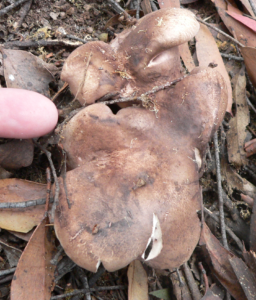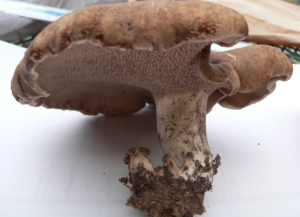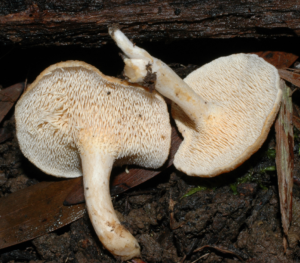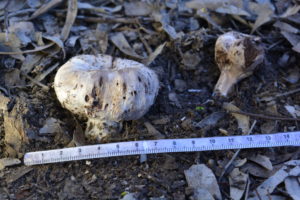Fungi come in many shapes and sizes. The gilled fungi or Agarics, widely known as ‘mushrooms and toadstools’ are very common. Listed here are the lost fungi of other shapes – including the Corals, Crusts, Morels, Pins, Polypores, Toothed fungi and Truffle-like fungi.
Corals
- Green-staining Coral – Phaeoclavulina abietina
Crusts
- Tea-tree Fingers – Hypocreopsis amplectens – CRITICALLY ENDANGERED
Morels
- Common Morel – Morchella esculenta group
Pins
- Two-toned Pin – Chlorovibrissea bicolor
Polypores
- Chestnut Polypore – Laccocephalum hartmannii
Toothed fungi
-
- Beenak Long Tooth – Beenakia dacostae – NEAR THREATENED
- Stemless Earpick – Auriscalpium sp. ‘Blackwood’ – ENDANGERED
Truffle like
- Arid Darkspore Truffle -Agaricus melanosporus
Corals
Corals as their name suggests are fungi that have shapes similar to marine coral. There are a number of fruit body forms with having erect or pendulous branches, that are simple or branched.
Green-staining Coral – Phaeoclavulina abietina

This coral-shaped fruit body is small, multi-branched, yellowish, staining green all over. It grows in clusters, on the ground in deep litter. Due to the small size and often yellow-green colour, this coral could easily be overlooked (see MAP). Synonyms Ramaria abietina and Clavaria abietina.
Fruit-body Description:
Size to 35 mm tall x 25 mm wide. Branches upright, slender, yellowish becoming green, axils (branch divisions) narrowly round. Branch tips bluntly pointed, yellowish becoming green. Stem to 15 mm long x 2 mm diameter, yellowish-green, white at base, arises from a white mycelial mat, white rhizomorphs present. Spore print yellow.
Notes:
This genus is assumed to be saprotrophic.
References:
*Text adapted from references.
*Grey P, Grey E 2018 A Little book of Corals. https://fungimap.org.au/little-book-of-corals-rev-3-released/
Look-alikes:
Sometimes the green-blue staining reaction are not as obvious so specimens appear yellow. There are other yellow Ramaria and Phaeoclavulina species but these do not have a green-blue staining reaction.
Crusts
Flat fungi that vary from thin to thicker, firm fleshy to tough, spreading fruit-bodies in a continuous layer to patches, rosettes of lobes or other arrangements, usually on the upper surface wood but occasionally on soil. Their hymenial surface may be rough, warted, wrinkled, cracked or smooth, and they usually have pores (ostioles) through which ascospores are ejected.
Tea-tree Fingers – Hypocreopsis amplectens – CRITICALLY ENDANGERED
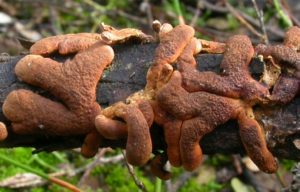
Found on falling or fallen branches of dead of tea-tree, paperbark and banksia in long-unburnt thickets but may also occur in warm and cool temperate rainforests (MAP). This rare fungus is a parasite on wood rot fungi. This firm-textured, brown, irregularly shaped species forms a raised mass of ‘fingers’ which clasps dead branches with light brown, finger-like lobes.
Fruit-body Description:
It grows up to 60 mm in length in a raised mass edged with irregular lobes up to 10mm wide. The lobes are brown with tips of paler yellowish-brown. White, powdery areas are often found on older specimens.
Notes:
Please do NOT collect nor disturb Tea-tree Fingers (Hypocreopsis amplectens) or host species.
At this point, we have not learned enough about the biology to know if collecting is detrimental to populations. Hypocreopsis is unusual, because it lives on other species of fungi, probably as a parasite – either on the fruit body or the mycelium; possibly both. The fruit bodies of Tea-tree Fingers may persist for several seasons. As yet we know very little about how it lives, which is why your help is so important.
It lives on wood-rotting fungi. The main host is thought to be the species of Hymenochaete shown below, which emerge as flat patches on the under surface of fallen logs and branches. It may also grow on species of Phellinus or other wood rot fungi.
References:
(Text has been adapted from these references* below)
Buchanan, P. & May, T. 2019. Hypocreopsis amplectens. The IUCN Red List of Threatened Species 2019: e.T80188449A80188453. (Accessed 02 January 2020).
*Grey P and Grey E 2005 Fungi down under: the Fungimap guide to Australian fungi. Fungimap: South Yarra, Victoria.
*McMullan-Fisher SJM 2021 How to identify and record information to help save Tea-tree Fingers. Fungimap.
Look-alikes:
Some other organisms bear a resemblance to Tea-tree Fingers. For example very old fruit bodies look a bit like lichen.
Pins
These are fungi that have their spore surface as a rounded head on a stem, with a pin like shape. These are often soft, moist and maybe gelatinous. Some slime moulds have similar shaped fruiting bodies but are much smaller.
Two-toned Pin – Chlorovibrissea bicolor

Chlorovibrissea bicolor, a tiny pin-shaped species has a round yellow head on a dark green stiff stem, which is attached to the substrate by a small basal disc (MAP). C. melanochlora is recognisable when it is an even dark green across the whole fruit body. Another pin, Brown-headed Pin (Vibrissea dura), is not green, rather has a brown head and pale stem.
Fruit-body Description:
A pin-shaped fruit-body up to 20 mm high; the head (pileus) of the fruit-body is fertile, globose or lobed, up to 5 mm diameter; colour yellow. Stipe up to 15 mm long, up to 1 mm thick; cylindrical or slightly tapering; surface smooth; colour dark green when fresh.
Notes:
There are three green Pins in Victoria and Tasmania: Chlorovibrissea bicolor, C. melanochlora and C. tasmanica. All Chlorovibrissea are rarely recorded and favour fruiting in very wet environments. C. bicolor differs from C. tasmanica in having a yellow head, a dark green, stiff stalk, larger asci with non-septate ascospores, and in the much shorter and short-celled hairs of the stalk; from C. melanochlora in not being totally green, in the smaller asci and ascospores and in the thinner tips to the paraphyses and from V. dura in having green pigmentation and smaller asci and ascospores.
References:
(Text has been adapted from these references* below)
*Beaton, G.W.; Weste, G. 1977: Australian discomycetes: a new Vibrissea species. Transactions of the British Mycological Society 69: 323-325.
*Grey P and Grey E 2005 Fungi down under: the Fungimap guide to Australian fungi. Fungimap: South Yarra, Victoria.
*Hubregtse, J CC-BY-NC-SA 2018 Fungi in Australia, Revision 2.1. Field Naturalists Club of Victoria Inc. E-published.
Look-alikes:

Chlorovibrissea melanochlora and C. tasmanica are both also green, but the latter has no images. So please record images and share any sightings under genus if species is in doubt. Microscopic characteristics of stem hair length and asci length are the definitive characters for identification.
Polypores
Polypores form large fruiting bodies with pores or tubes on the underside. These are often tough and woody but some are softer and more fleshy. They may have stems while others have broader attachment often to wood like logs and butresses, often also called Bracket fungi, or shelf fungi. Most commonly Polypores are found on wood, some are found on the ground.
Chestnut Polypore – Laccocephalum hartmannii
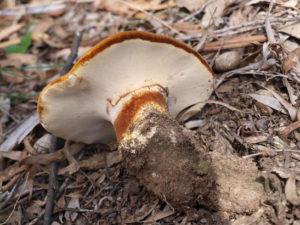
When mature this large fleshy polypore has stem and the rich, velvety red-brown cap and stem, often cracks when dry to expose bright mustard-yellow flesh. The under-surface are pores that are minute and cream coloured when young but age to a dirty cream colour.
Fruit-body Description:
Annual, with central or eccentric stem, solitary or in groups of 3-4, either on wood or directly developing from a terrestrial pseudosclerotium; pileus circular to reniform, convex, 5-15 cm in diameter, up to 1 cm thick, upper surface reddish-brown with orange periphery, finely velutinate, concentrically areolate when old; pore surface cream to orange, pores angular, brittle, 3 to 6 per mm; context white to cream, up to 1.5 cm thick, corky, with resinous zones; stipe 4 cm long, up to 3 cm thick, single to bifurcate, orange to brick-coloured, even or finely velutinate, with a cortex.
Notes:
These emerge from storage organs, usually buried under ground, amongst litter but occasionally have been known to fruit upon tree trunks. They appear to be triggered into fruiting by drought or mechanical disturbance. This and other fungi that produce storage organs are called stonemaker fungi (Laccocephalum, Neolentinus and Pleurotus tuber-regium).
References:
(Text has been adapted from these references* below):
*Cooke MC 1883 Australian fungi, Grevillea 12: 8-21.
*Grey P & Grey E 2005 Fungi Down Under – the Fungimap Guide to Australian Fungi, Fungimap.
Look alikes:
Other Stonemaker fungi (do not have mustard coloured flesh). Amauroderma species, these are tougher and pores often stain when touched. Large boletes like Phlebopus marginatus have softer and yellow pores are often much larger stem.
Toothed fungi
Toothed fungi or often called ‘hydnoid fungi’ do not have gills nor pores rather they have pegs or tooth-like or spine-like of tissue hanging down. As well as these two lost fungi species of Flesh tooths (Sarcodon and Hydnellum) and Velvettooths (Phellodon) are likely uncommonly recorded. Other common toothed fungi include Coral Tooth (Hericium coralloides) and Golden Splash Tooth (Phlebia subceracea)
Beenak Long Tooth – Beenakia dacostae

This is a small, irregularly shaped stalked spine fungus. The teeth are initially white, becoming olive-brownish as spores mature. The thin stem is woody and often coloured pale brown with spores; with white mycelium at the base. Commonly found (MAP) growing on dry, woody debris or rotten branches in wet eucalypt forests.
Fruit-body Description*:
Cap has a diameter to 25 mm; round to kidney-shaped, ageing flat to wavy; white, cream to ochre, drying to yellow-brown; smooth, cottony with soft matted hairs; margin often lobed. Central, off-centre or lateral stem; length to 30 mm, diameter to 3 mm, often poorly developed; slightly curved; white, yellow-brown at apex; woody, smooth, cottony with soft hairs. Basal mycelium white, matted. Teeth are decurrent; length to 10 mm; slender, tapering to a point; crowded; pale olive-brown with maturity.
References:
(Text has been adapted from these references* below):
Grey* P and Grey E 2005 Fungi down under: the Fungimap guide to Australian fungi. Fungimap: South Yarra, Victoria. p. 18
Hubregtse*, J CC-BY-NC-SA 2018 Fungi in Australia, Revision 2.1. Field Naturalists Club of Victoria Inc. E-published at FNCV.
May, T., Leonard, P.L. & Cooper, J.A. 2019. Beenakia dacostae . The IUCN Red List of Threatened Species 2019: e.T154843178A154843191. (Accessed 02 January 2020).
Look alikes:
There are other Tooths that are paler and with a stem. These include species of Hydnum, some yet to be named but include the common Wood Hedgehog (Hydnum repandum). May also be confused with paler species of Phellodon, Hydnellum and Auriscalpium.
Stemless Earpick – Auriscalpium sp. ‘Blackwood’ – ENDANGERED

Reiner Richter)
This small brown laterally attached fungus has relatively long brown teeth, is fleshy in texture, but not gelatinose. Found growing from the stringy bark of the Narrow-leaved Peppermint Gum.
Despite searches on other stringy barks in Victoria so far this is only known from a single trees each in two populations: one in the Wombat State Forest and a new population from June 2019 in the Dandenong Ranges. So is exceedingly rare with just two known populations. Preliminary taxonomic work suggests that it is a new species (Clauss 2018).
Fruit-body Description1*:
This very rare distinctive fungus is readily identified by its small semicircular to shell-shaped fruit-body and distinctive long spines. It usually grows on the bark of the Narrow-leaved Peppermint Gum (Eucalyptus radiata).
References:

(Text has been adapted from these references* below):
*Clauss B 2018 Please don’t pick your ears! Fungimap Newsletter 59: 7-8.
Global Fungi Red List Initiative Auriscalpium sp. ‘Blackwood’ (Accessed 27 Nov 2019).
*Hubregtse, J CC-BY-NC-SA 2018 Fungi in Australia, Revision 2.2. Field Naturalists Club of Victoria Inc. E-published at FNCV.
May, T. 2019. Auriscalpium sp. nov. ‘Blackwood’ . The IUCN Red List of Threatened Species 2019: e.T154932417A154932424. Downloaded on 01 January 2020 (Accessed 2 January 2020).
Look alikes:
The most similar fungus is the laterally attached, Toothed Jelly Fungus (Pseudohydnum gelatinousm), this has a distinctly gelatinous texture. There are other species of Auriscalpium, but so far these have long often central stems.
Arid Darkspore Truffle- Agaricus melanosporus
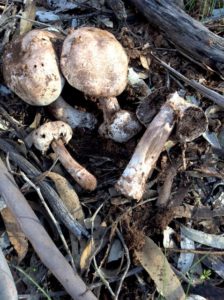
There are two named Arid Agaricus Truffles for Australia so far these are A. erythrosarx and A. melanosporus, there are likely more species than this to be discovered. Microscopic examination are needed for most identifications.
Agaricus melanosporus Fruit-body Description*:
Sporocarps emergent, solitary to gregarious. Pileus 15–28 mm high 3 10–23(–28) mm diam, subglobose to planoconvex, light cream to pale brown, smooth to finely fibrillose, becoming brittle when dried. Context fleshy when fresh, compact, white, no color change.Hymenophore pale brown to dark purple-brown, sublamellate to elongated labyrinthine; moist becoming powdery. Stipe 5–16 mm long 3 3–6 mm diam, percurrent or truncated, pale cream, fibrous, context pale with no staining reactions, protruding shortly below excavated hymenophore. Odor not recorded.
Microscopic Features:
Spores (6–)7–8 3 (5–)6–7 mm, mean 7.4 3 6.7 mm, Q 5 1.0–1.3, globose to subglobose, some slightly asymmetric, pale yellowish brown to brown in KOH, non-dextrinoid. Basidia 15–22 3 5–9 mm, elongate clavate to cylindrical; sterigmata four. Pileipellis a cutis, 24–42 mm wide, of subparallel, interwoven, hyaline hyphae 2–5 mm diam and scattered inflated elements 7–14 3 5–10 mm, overlying a context, 45–80 mm wide, of loosely interwoven hyaline hyphae, 2–5 mm diam. Clamps not observed.
References:
(Text has been adapted from these references* below):
*Lebel, T. and Syme, A. (2012). Sequestrate species of Agaricus and Macrolepiota from Australia: new combinations and species, and their position in a calibrated phylogeny. Mycologia 104, 496–520.
Look alikes:
As there maybe other unknown species of truffle-like Agaricus all sightings should be shared.
Amongst the known look alikes Agaricus melanosporus and A. erythrosarx but so far Longula texensis (syn. Agaricus deserticola) is NOT known from Australian.
Agaricus erythrosarx resembles A. melanosporus both macro and microscopically. Both species have large pale sporocarps with scattered vinaceous fibrils on the surface, a sublamellate hymenophore that becomes pulverant, reddening pileal flesh and small spores. Differences include the red-orange staining reaction of the hymenophoral trama and reddening of the stipe context in A. erythrosarx and the lack of color changes in A. melanosporus (some dingy brown stains at base of stipe), and narrower basidia (5–9 mm vs. 9.5–14mm) and slightly larger spores in A. melanosporus.

